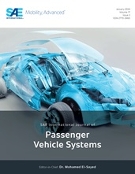Your Destination for Mobility Engineering Resources
Announcements for SAE Mobilus
Browse All1 of 2
2 of 2
3 of 2
Recent EDGE Research Reports
Browse All 1421 of 2
2 of 2
3 of 2
4 of 2
5 of 2
Latest Journal Issues
Browse All 161 of 3
2 of 3
3 of 3
4 of 3
5 of 3
Recent Books
Browse All 9361 of 2
2 of 2
3 of 2
4 of 2
5 of 2
Recently Published
Browse AllEffective contrail management while ensuring operational and economic efficiencies for flight services is essential for providing services with minimal adverse environmental impact. The paper explores various aspects of contrail management applicable to different platforms such as Unmanned vehicles, Commercial airliners, and Business & regional jets. The aspects unique to each platform such as flight levels of operation, fuel types, flight endurance and radius of operation have been analyzed. Expanse of 5G network is resulting in increased flight activity at flight levels not envisaged hitherto. The paper also dwells on the ramifications of the increased proliferation of different platforms at newer flight levels from the perspective of contrail management. This paper introduces a framework that integrates the dual objective of minimizing contrail effects while optimizing fuel consumption for commercial aircraft by considering various factors like flight levels, geothermal data, and
A Gerotor pump is a positive displacement pump consisting of inner and outer rotors, with the axis of inner rotor offset from axis of outer rotor. Both rotors rotate about their respective axes. The volume between the rotors changes dynamically, due to which suction and compression occurs. Due to their high-speed rotations, a Gerotor pump may be subjected to erosion due to cavitation. This paper details about the Computational Fluid Dynamics (CFD) based methodology that has been used to capture cavitation bubbles, which might form during the operation of Gerotor pump and to identify the erosion zone which might be occur due to cavitation bubble getting burst near the surface layers of the gears. A full scale (3D) transient CFD model of a Gerotor pump has been developed using commercial CFD code ANSYS FLUENT. The most challenging part of this CFD flow modeling is to create a dynamic volume mesh that perfectly represents the dynamically changing rotor fluid volume of the Gerotor pump
In any human space flight program, safety of the crew is of utmost priority. In case of exigency in atmospheric flight, the crew is safely and quickly rescued from the launch vehicle using Crew Escape System (CES). CES is a critical part of the Human Space Flight which carries the crew module away from the ascending launch vehicle by firing its rocket motors (Pitch Motor (PM), Low altitude Escape Motor (LEM) and High altitude Escape Motor (HEM)). The structural loads experienced by the CES during the mission abort are severe as the propulsive, aerodynamic and inertial forces on the vehicle are significantly high. Since the mission abort can occur at anytime during the ascent phase of the launch vehicle, trajectory profiles are generated for abort at every one second interval of ascent flight period considering several combinations of dispersions on various propulsive parameters of abort motors and aero parameters. Depending on the time of abort, the ignition delay of PM, LEM and HEM
A structural load estimation methodology was developed for RLV-TD HEX-01 hypersonic experimental mission, the maiden winged body technology demonstrator vehicle of ISRO. Primarily the method evaluates time history of station loads considering effects of vehicle dynamics and structural flexibility. Station loads of critical structures are determined by superposition of quasi-static aerodynamic loads, dynamic inertia loads, control surface loads and propulsion loads based on actual physics of the system, improving upon statistical load combination approaches. The technique characterizes atmospheric regime of flight from vehicle loads perspective and ensures adequate structural margin considering atmospheric variations and system level perturbations. Features to estimate change in loads due to wind variability and atmospheric turbulence are incorporated into the load estimation methodology. Augmentation in loads due to structural flexibility is assessed along the trajectory using vehicle
With the upcoming technology demonstration projects such as the Reusable Launch Vehicle, easily portable data acquisition systems for ground testing are the need of the hour. The existing data acquisition systems used in ISRO are generally larger and of higher capability based on the number parameters to be acquired, which makes them underutilized in this case. To avoid this problem, a data acquisition system based on BeagleBone® Black, a Single Board Computer (SBC) is conceived. With this approach the number of components utilized would be reduced as we make use of ADCs present in the BeagleBone computer. Also, the size of the hardware setup is significantly reduced as the chosen SBC is small, making the developed Data Acquisition system portable. It could be moved anywhere with ease, even to the runway, where the final phase of ground testing happens
In recent decades, innovative System-on-Chip (SoC) design has become a critical area of research, driven by emerging trends and complex application demands. SoCs, which integrate analog, digital, and mixed-signal components, along with software, present significant design and verification challenges. Modeling and Simulation constitutes a powerful method for designing and evaluating these complex systems, enabling system designers in concept realization, experimentation, optimization, and validation. This paper introduces a ‘Synergized SoC design flow with Modeling and Simulation’ applied in the design and development of SoC for a radar target emulator application. This synergized flow uniquely integrates system-level modeling and simulation with the traditional SoC design and development process to effectively address design and verification needs. Our approach not only accelerates the SoC design cycle time but also provides a comprehensive framework for future innovations in the SoC


